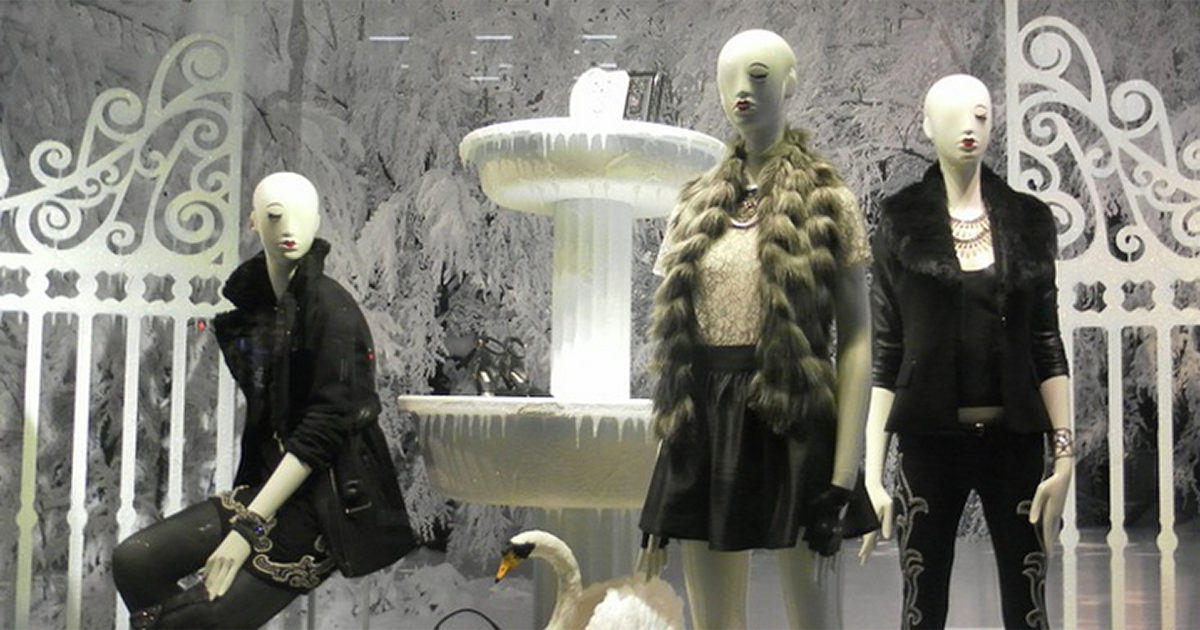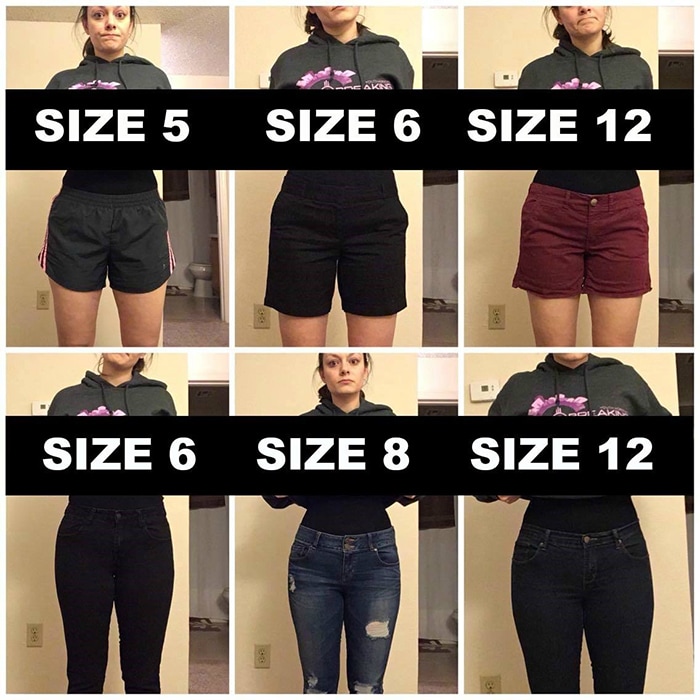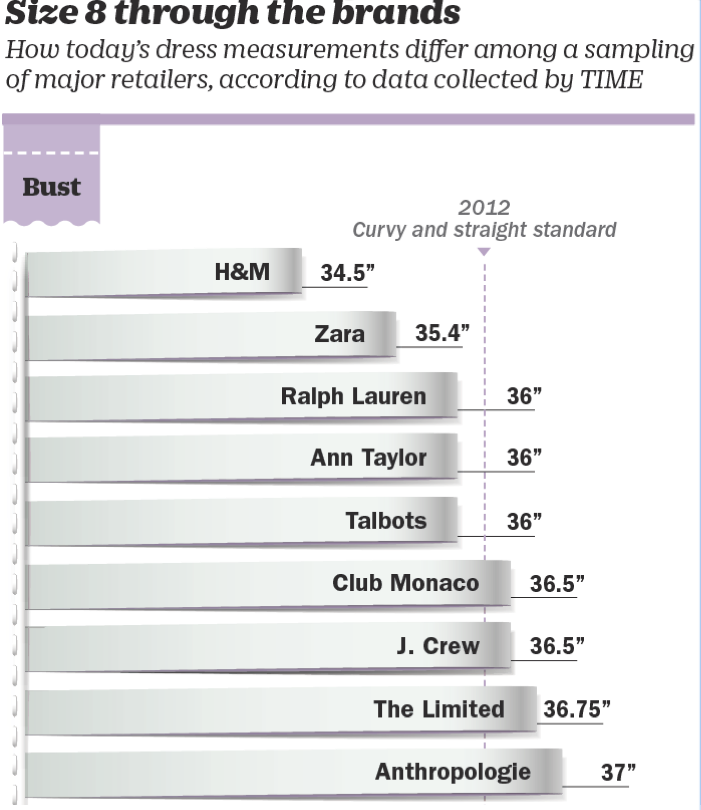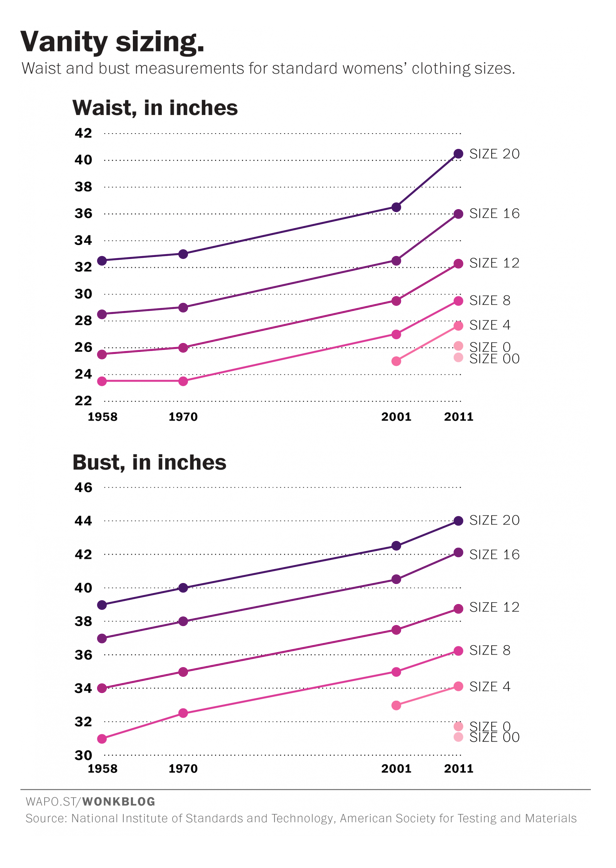Who to Believe?
|
|
I recently went shopping with friends to a number of our favorite thrift shops and found a long linen coat, a sweater, two shirts and three dresses. All of the items fit and I bought them.
For non-thrift store afficianados, the first piece of advice I have for you is to avoid shopping by size. You may miss some great buys that way. The coat I bought was a size 6, the sweater was a medium; one shirt was an XS, and the other a large. The first dress I bought was a 6, the second was a 2, and the third was a 0. Really? A zero? That is absurd. This is Deena Shoemaker. She is a teen counselor and a frustrated buyer of women’s clothing. These are the photos she posted on her Facebook page to illustrate a point. Clothing sizes make no sense. Her travails were written up the in Business Insider. |
Mind, Body, Spirit
|
How did we get in this predicament?
Before ready-to-wear, there was made-to-measure. Measurements were made, patterns cut and sewn, and clothing fitted. Who knew or cared what “size” they were? In 1939, the U.S. Department of Agriculture (USDA) began a yearlong study titled “Women’s Measurements for Garment and Pattern Construction.”
Working with the Bureau of Home Economics under a federal grant, they studied the weight and 58 body measurements of 14,698 women across seven states in the U.S. Once the final data was collated, statisticians analyzed the results and determined that five measurements were sufficient to determine the size and shape of a woman: weight, height, bust girth, waist girth and hip girth.
Weight was quickly dismissed as a measurement, analysts reasoning that “retail stores and homes frequently do not have scales and it is conceivable that women would object to telling their weights more than to giving, say, their bust measurements.”
Just a few of the biases included limiting the USDA study to white women, and the suggestion, after all the work was done, to recommend that mass manufacturers only produce every second clothing size. The study was completed in 1953 and published as “Commercial Standard (CS) 215-58.”
In 1970 the commercial standards were updated, partially in recognition that few women actually had an hourglass shape. In 1939 it was estimated that many women fit this mold, maybe due to restrictive undergarments, and now the percentage is about 8 percent. The new standards were voluntary for manufacturers.
With no real restrictions, retailers were limited only by their imaginations, and garments started to be labeled with smaller sizes. By 1983 the voluntary standards were gone, and all that is left is size numbers.
Categories
All
15 Minutes
Across The Bridge
Aloha Diamondhead
Amtrak
Antiques
Architecture
Art
Arts Alive
Arts Locale
At Home In The Bay
Bay Bride
Bay Business
Bay Reads
Bay St. Louis
Beach To Bayou
Beach-to-bayou
Beautiful Things
Benefit
Big Buzz
Boats
Body+Mind+Spirit
Books
BSL Council Updates
BSL P&Z
Business
Business Buzz
Casting My Net
Civics
Coast Cuisine
Coast Lines Column
Day Tripping
Design
Diamondhead
DIY
Editors Notes
Education
Environment
Events
Fashion
Food
Friends Of The Animal Shelter
Good Neighbor
Grape Minds
Growing Up Downtown
Harbor Highlights
Health
History
Honor Roll
House And Garden
Legends And Legacies
Local Focal
Lodging
Mardi Gras
Mind+Body+Spirit
Mother Of Pearl
Murphy's Musical Notes
Music
Nature
Nature Notes
New Orleans
News
Noteworthy Women
Old Town Merchants
On The Shoofly
Parenting
Partner Spotlight
Pass Christian
Public Safety
Puppy-dog-tales
Rheta-grimsley-johnson
Science
Second Saturday
Shared History
Shared-history
Shelter-stars
Shoofly
Shore Thing Fishing Report
Sponsor Spotlight
Station-house-bsl
Talk Of The Town
The Eyes Have It
Tourism
Town Green
Town-green
Travel
Tying-the-knot
Video
Vintage-vignette
Vintage-vignette
Waveland
Weddings
Wellness
Window-shopping
Wines-and-dining
Archives
July 2024
June 2024
May 2024
April 2024
March 2024
June 2023
March 2023
February 2023
January 2023
December 2022
November 2022
October 2022
September 2022
August 2022
July 2022
June 2022
May 2022
April 2022
March 2022
February 2022
January 2022
December 2021
November 2021
October 2021
September 2021
August 2021
July 2021
June 2021
May 2021
April 2021
March 2021
February 2021
January 2021
December 2020
November 2020
October 2020
September 2020
August 2020
July 2020
June 2020
May 2020
April 2020
March 2020
February 2020
January 2020
December 2019
November 2019
October 2019
September 2019
August 2019
July 2019
June 2019
May 2019
April 2019
March 2019
February 2019
January 2019
December 2018
November 2018
October 2018
September 2018
August 2018
July 2018
June 2018
May 2018
April 2018
March 2018
February 2018
January 2018
December 2017
November 2017
October 2017
September 2017
August 2017
July 2017
June 2017
May 2017
April 2017
March 2017
February 2017
January 2017
December 2016
November 2016
October 2016
September 2016
August 2016
July 2016
June 2016
May 2016
April 2016
March 2016
February 2016
January 2016
December 2015
November 2015
October 2015
September 2015
August 2015
July 2015
June 2015
May 2015
April 2015
March 2015
February 2015
January 2015
December 2014
November 2014
August 2014
January 2014
November 2013
August 2013
June 2013
March 2013
February 2013
December 2012
October 2012
September 2012
May 2012
March 2012
February 2012
December 2011
November 2011
October 2011
September 2011
August 2011
July 2011
June 2011































 RSS Feed
RSS Feed























